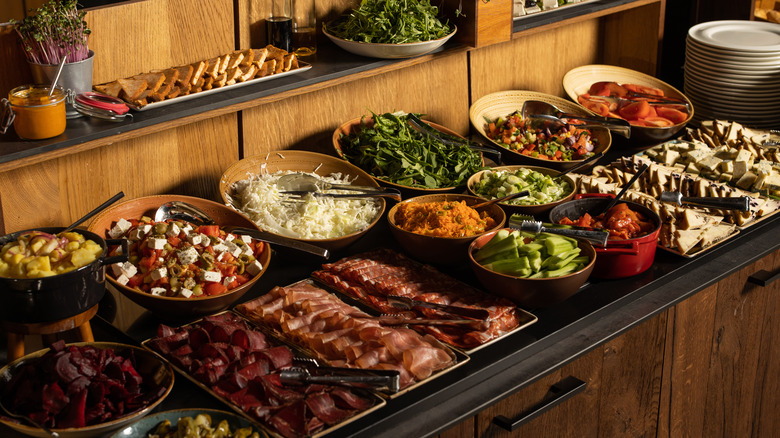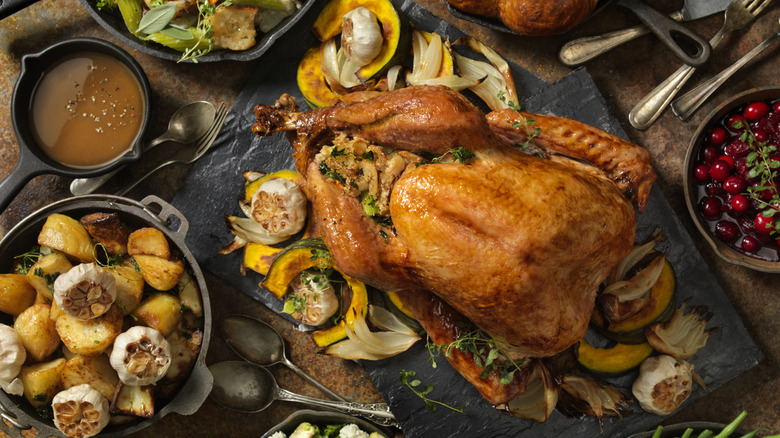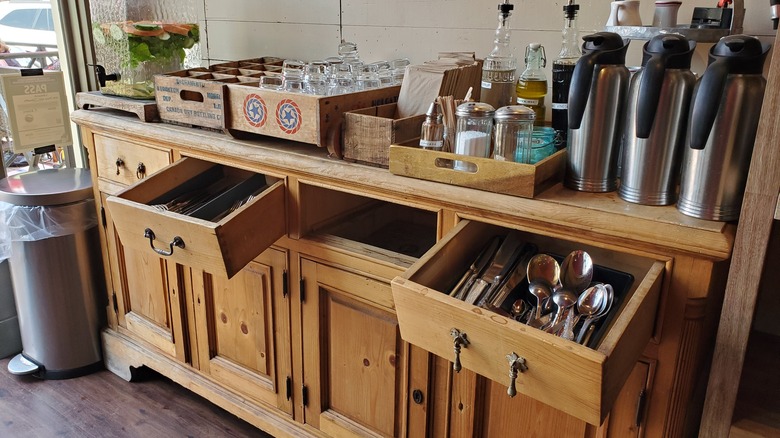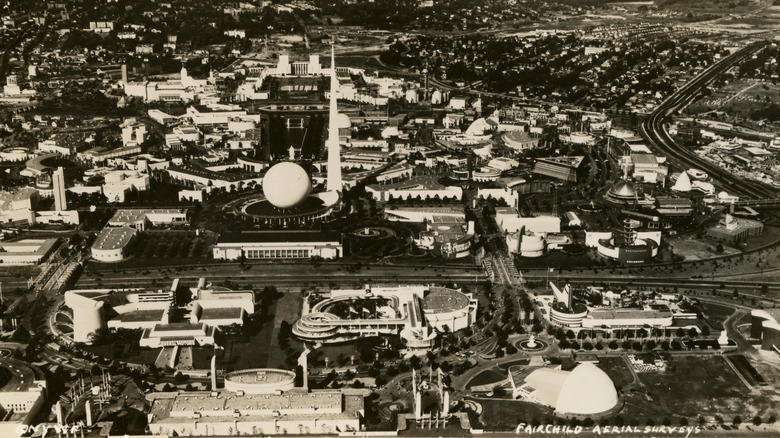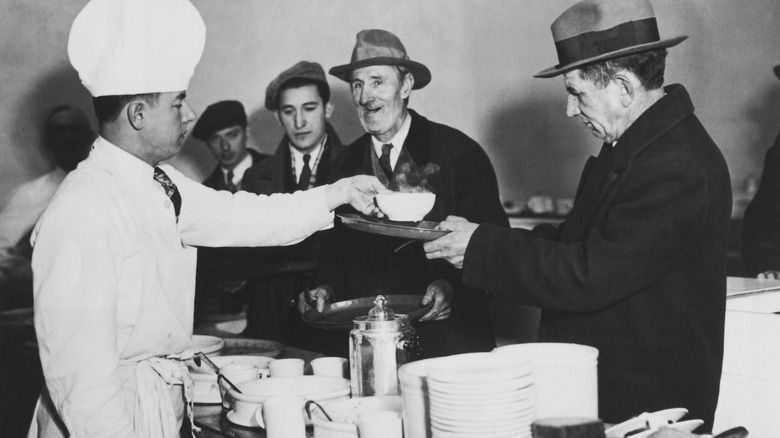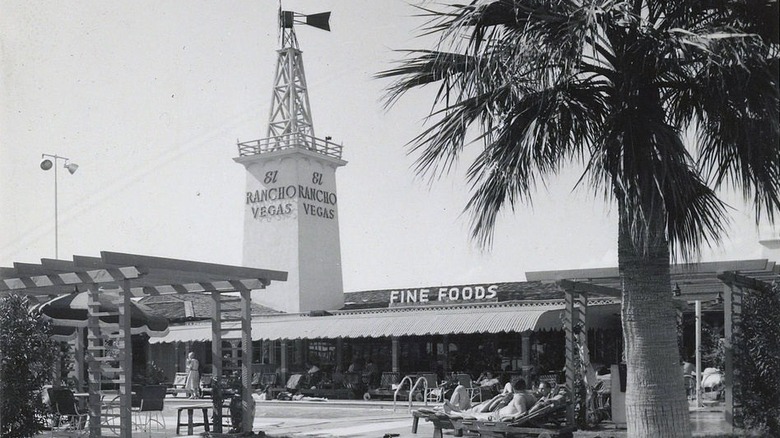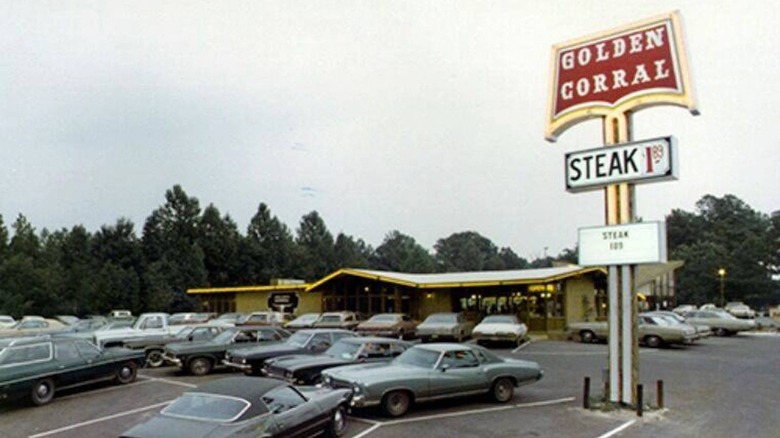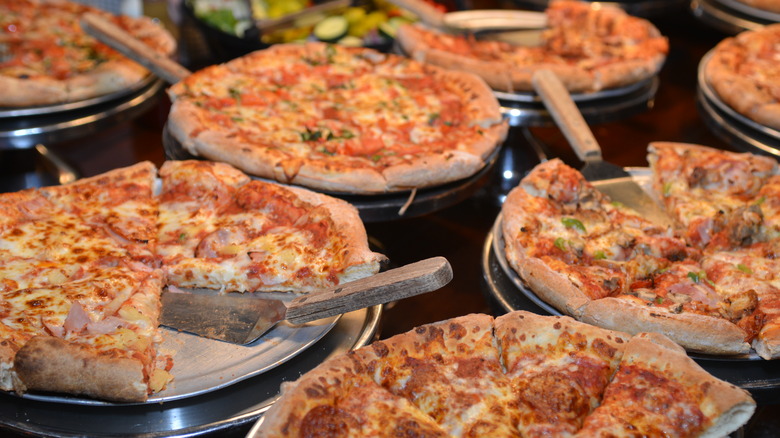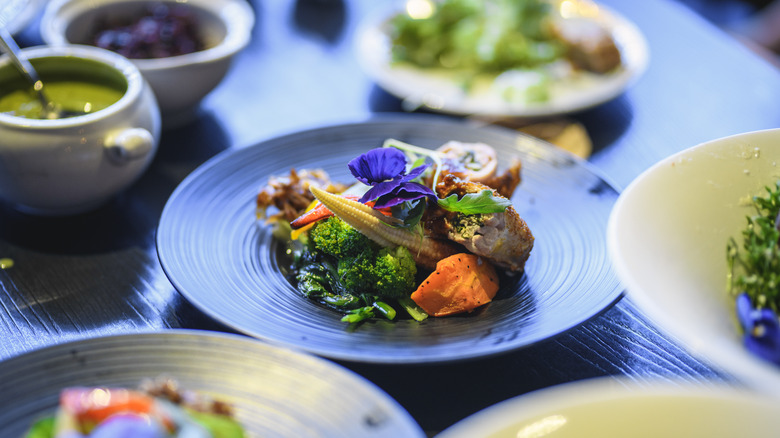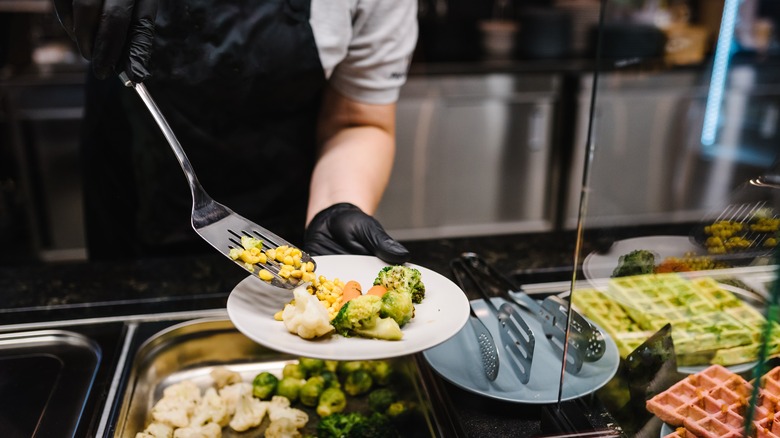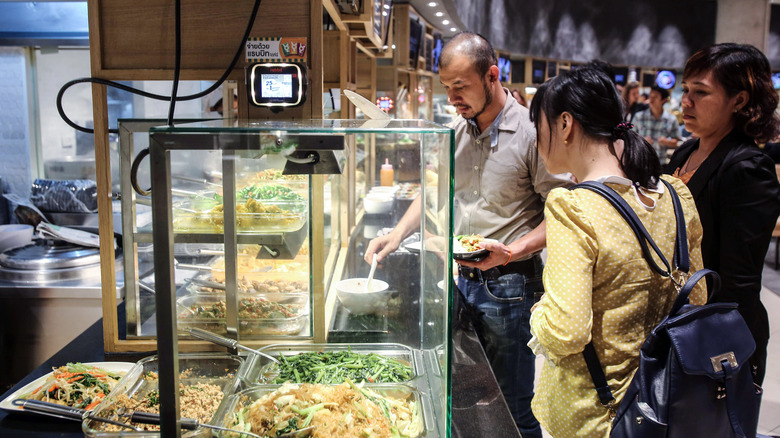The Untold History Of All-You-Can-Eat Buffets
People usually think of all-you-can-eat buffets as American institutions. The large portions and never-ending spread of foods speak to a supersized agenda that seems quintessentially American. However, Americans were not the first, nor were they the only group to indulge in an all-you-can-eat feast. While the first commercial all-you-can-eat buffet restaurant is thought to have originated in the Southwest United States, humanity has been feasting for thousands of years in one way or another.
The history of this way of dining spans millennia before finding its way to the modern iteration, from ancient Rome to 16th-century Sweden. Even the last 100 years have seen the rise, fall, and rise again of the all-you-can-eat buffet as tastes, diets, and economies have all changed, leading to fluctuation in their popularity. Most recently, the COVID-19 pandemic made its mark on the industry as people became more conscious of the spread of germs. The amount of touching and lack of health regulations enforced on buffets left their mark. But this is just one phase in the long history of the all-you-can-eat buffet.
Feasts through history
Long before the rise of ancient Rome, people came together to eat large amounts of food in lavish ways. But the practice was so popular with ancient Romans that it sparked a long-held myth that feasts included a "vomitorium," or a place where the Romans could go to vomit in order to prepare for the next course. This unpleasant part of their feast is now considered inaccurate, but no one doubts the ancient Romans' love of a lavish and continuous meal.
The Celts used feasts to commemorate the changing of seasons. Spits of meat and stews were prepared, along with seasonally appropriate fruits and vegetables, served on plates often made of bronze. Of course, all of this was washed down with wine and mead, leading to a joyous and robust celebration. Feasts have not just been used as a way to eat a lot, but also to celebrate events and commune together. Weddings, holidays, and notable occasions across cultures have used feasts to mark important times.
16th-century Sweden
The practice that inspired the modern-day all-you-can-eat buffet comes from 16th-century Sweden. At the time when feasts were popular to avoid underfeeding the guests, it became traditional to provide a brännvinsbord to pre-game the meal. The brännvinsbord was a display of appetizer-like foods, such as meats and cheeses, that guests could eat at their pleasure.
The name brännvinsbord literally means "table of spirits," and while we are sure the table kept people's spirits up, there was another kind of spirit that was an important part of the table, and that was Brännvin. Brännvin was a spiced vodka that accompanied the food and the brännvinsbord. Later additional alcohol, such as beer, would also be included.
There is some thought that the Swedes got the idea of pairing appetizers and spirits from the Russians, who enjoyed eating small snacks while sipping vodka. However, it was in Sweden that the idea took on a new life and place in society, setting it up to move from a precursor to the meal to becoming the meal itself.
A true smörgåsbord
The Swedes were not the only ones who enjoyed the brännvinsbord; this was also a popular meal tradition in Finland. By the 18th century, the brännvinsbord was taking center stage and had become the meal itself, known as a smörgåsbord. While in American vernacular, the term is often used to describe a large amount of something, in Sweden, it is specific to food and means "butter-goose table."
One of the significant differences between the ancient feasts, the brännvinsbords, the smörgåsbords, and today's all-you-can-eat buffets is the position they held in society. Whereas today, we think of all-you-can-eat buffets as an economical choice based on quantity, not necessarily quality, back then, feasts and dining in this manner was something for the elite and was a trendy way to eat. Even today, the smörgåsbord is something approached with a delicate hand and often features traditional items such as pickled herring. Not only are the foods eaten with more restraint, but they are also eaten in a specific order, with the eater moving through cold fish and cheeses, to room temperature ones, to warm ones, and finally on to dessert.
Spread through Europe
Of course, western Europe did not want to be left out of the food festivities. While having food served to you had been all the rage in fine dining for hundreds of years, in England and France, the idea of displaying food that people would pick from as they desired began to take off. These displays were often used for breakfast in the 18th century. This style of eating allowed for communing with guests or family members, and for more privacy than a traditionally served meal, which we understand. Sometimes you just want some quiet in the morning. This could be seen as the start of the breakfast buffet, now a staple in mid-range hotels across America.
At this point, the foods were often served on a sideboard, a piece of furniture now used to house dishes and display food. The French word for this type of furniture is "buffet." As the style of eating gained traction in the English-speaking part of the world, the term was adopted to refer to the meal itself instead of simply referring to the furniture it was served on.
Spread to America
With the rising popularity of self-serve eating through the centuries, it was only a matter of time before the tradition gained popularity. Two key events helped spread the practice to America. The first was in 1912 when the Olympics were held in Stockholm, Sweden. During this time, instead of providing traditional waiter-provided restaurant service, restaurants opted to serve smörgåsbords as a way to meet the high demands of tourists desperate for a meal.
The second was in 1939 at the World's Fair in New York. In the Swedish pavilion at the fair, a restaurant called the Three Crowns offered a traditional smörgåsbord to all those who came. Finally, the smörgåsbord had landed on American soil, and the idea took off. In the first half of the 20th century, self-service lunch meals began to gain traction on both sides of the Atlantic. Hotels of the time recorded an uptick in hosted buffet-style luncheons. British hotel Runnymede's housekeeping records note guests specifically requesting foods that did not require a knife, as guests would be standing to eat.
The Great Depression
Then tough economic times hit. Between 1929 and 1939, America's economy hit a sustained low, now known as the Great Depression. During this time, many Americans struggled financially, often struggling with basic needs such as food. Even those who managed to retain wealth felt the struggle. This caused a shift in dining habits that favored buffet meals in the home. Buffets offered large quantities of food and did not require paid serving staff. Perfect for the economics of the day.
With buffets becoming more popular, the Chase Brass & Copper Company saw a potential business opportunity. The company designed an early electric buffet that kept the food hot and safe to eat — utilizing electric coils that heated a tray of water placed under pans of food, not dissimilar to what is still used today for warm food.
The electric buffet was released in 1933. While risky, the electric buffet was ultimately a success, finding a place in many people's homes. Emily Post, an etiquette writer of the day, wrote a short booklet titled "How to Give Buffet Suppers" to help promote the buffet server. Without this innovation due to the Depression, the groundwork for restaurants' all-you-can-eat buffets would not have been set.
Buckaroo Buffet
All of these societal changes and innovations bring us to the first all-you-can-eat buffet restaurant in America. In the 1940s, Las Vegas was just becoming what it is today. Casinos began opening, with El Rancho Vegas among them and with Herb McDonald as an employee. As with many innovations, there is a mythos around the titular idea that started it all. McDonald was said to be working late at night when he got hungry. He put together a cold cut board, perhaps inspired by smörgåsbord at the 1939 World's Fair. He began eating from it at the bar, and people passing by took notice and wanted to indulge. This gave McDonald an idea. And in 1945, he opened the Buckaroo Buffet with El Rancho Vegas.
Buckaroo Buffet is widely considered to be the first all-you-can-eat buffet restaurant in the United States. Buckaroo Buffet was open 24 hours a day and cost consumers only a dollar. While the buffet itself did not earn money; it proved positive for business for the casino, and inspired generations of all-you-can-eat buffets to come.
Height of American popularity
The popularity of the all-you-can-eat continued to grow through the next several decades. No longer were buffets consigned to home parties or casinos. Independent buffets and chain restaurants began to spring up. Even restaurants that had à la carte menus also began to offer buffets. The enticement of all-you-can-eat options was just too much for the populace to resist, so more and more consumers opted for the buffet. This, of course, was great for restaurants, as buffets did not require the same level of wait staff as traditional dining. It also worked out for consumers, who saw a fixed-price all-you-can-eat buffet as a good economic choice.
The 1980s became a golden age for American all-you-can-eat buffets. Popular chains sprang up, such as Golden Corral, which was founded in 1973, and Cicis, which was founded in 1985. Restaurants such as Pizza Hut began offering buffets, and more and more hotels made it standard practice, especially for breakfasts. Buffets were the hot food option.
Waning popularity
Nothing lasts forever, though, and not long after the height of the 1980s, buffets started to decline. Part of this was due to an overabundance. Expansions and franchising caused an explosion of buffets across the country, but with so much supply, even the high demand was not enough to keep up.
All-you-can-eat buffets are notoriously low-margin endeavors. Restaurateurs bank on quantity over quality and specifically design the layout of buffets to push low-cost and high-filling foods over pricier ones. By 1998, 26% of American buffets had closed their doors. And this was just the beginning. Trends continued downward, and in 2016 once popular chain HomeTown Buffet filed for bankruptcy. Ponderosa, which once had 305 locations, was down to 75 in 2019 after the company that owned it filed for bankruptcy in 2008. Pizza Hut, while still operational, has, for the most part, closed the buffets for its remaining American locations. All of this seemed to spell the end of all-you-can-eat buffets.
American dietary changes
It was not just the oversaturation of the market that caused the decline of the all-you-can-eat buffet, but a change in how Americans eat. First came new diets focusing on low fat, low carbs, low sugar, or whatever the diet of the day was. As America moved into the 2000s, there was an increasing emphasis on diet culture, which is now widely recognized as unhealthy and harmful. These increasingly restrictive food trends did not bode well for the buffet market based on excess.
Then, of course, food trends shifted from quantity to quality, with consumers caring about the origins of their food. Farm-to-table restaurants and haute cuisine came to the forefront, leaving behind the food on a hot plate in a bar. It is also possible that the rise in food allergies encouraged people to stay away from the buffet. Food allergies in the United States have doubled since the heyday of the buffet. With concerns about cross-contamination and uncertain food sources, it is easy to see why the buffet is not always the first choice for someone with food allergies.
COVID-19 pandemic
The all-you-can-eat buffet industry was already suffering, then came what could have been the final nail in the coffin — the COVID-19 pandemic. Many sectors suffered during the pandemic, which caused mass shutdowns, but perhaps none were hit harder than the restaurant industry. Some estimates say that by 2021, 90,000 restaurants had closed in some way due to COVID-19. As an already struggling industry, buffets at first appeared to be worse off than other restaurant types. Concerns about safety related to touching equipment and shared food meant that buffets suffered. In 2021, Old Country Buffet's parent company filed for bankruptcy.
However, other companies, such as Golden Corral, were able to shift how they did business, offering delivery and no-touch buffets where customers are served by employees, so as to avoid mass amounts of strangers touching the same utensils. While these restrictions did not last for the long haul, and most are back to self-service, they helped keep the company afloat during a difficult time. Golden Corral also maintained stricter health and safety guidelines.
While Golden Corral stayed open, some experts were not convinced that these shifts would ultimately bring back the buffet. San Diego-based restaurant analyst John Gordon pronounced that the "buffet model is dead" (via Politico). However, the experts may have spoken too soon.
Resurgence in popularity
As restrictions on the COVID-19 pandemic lifted and people went back to a new normal, Americans were hit with economic difficulties. Left over from the pandemic came supply chain issues and inflation, which saw record increases in the price of food. Restaurant and grocery store prices kept creeping up, and Americans ate out less. In parallel to the Great Depression, we are now seeing the buffet profiting off this change in diet and economics. While full-service restaurants and fast-casual restaurants saw a decrease in patronage, the unlikely underdog of the all-you-can-eat buffet saw an increase.
Chains such as Golden Corral reported revenue increases between 2020 and 2023. This upturn is at least partially attributed to a return to Americans looking for value in the quantity of food. All-you-can-eat buffets have always been about quantity at a fixed price, making it a good option for those looking to eat out on a budget.
Of course, the landscape of the buffet has also changed in ways to attract the younger generation, too. More care is now often taken with plating to make food Instagrammable, and the many buffets are going further than ever to reduce costs related to food waste. All this has helped bring the once-floundering buffets into the 21st century, where they have once again become an American staple.
Buffets outside the United States
Of course, buffets are not just a thing in America. Smörgåsbords remain popular in Sweden, as well as in other Scandinavian countries. Buffets also remain popular in the U.K. and Europe, where it is not unusual to be charged an extra fee for food that you took but did not consume. Here the buffets are staying very literal with all-you-can-eat and no more. Asia, too, has a variety of different buffet experiences based on where you are. Mongolian barbecue buffets, seafood buffets, and hot pot buffets can be found all over. Each culture has its own take on the self-serve meal.
Additionally, despite functionally going extinct in America, Pizza Hut successfully exported its all-you-can-eat buffet, finding its home in Australia and all over the United Kingdom. We can only hope that this means someday we may see a resurgence of these once-beloved buffets back in America. We are sure millennials would jump at the opportunity to chase down some nostalgia with greasy pizza.
